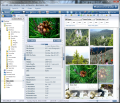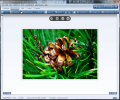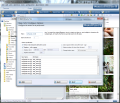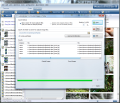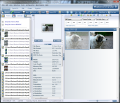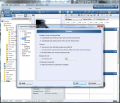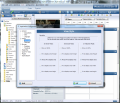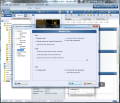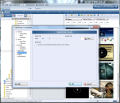Although the name hints at the purpose of the application, Ashampoo Photo Commander is more than a simple organizer for the images on your computer. Its skills go beyond arranging the items as it can process pictures and rename or resize them, weld them into a slideshow, collage or album as well as edit them. You can use the application to organize video files (AVI, WMV, MPG) and audio ones (MP3, WMA, WAV).
There is a new installer to Ashampoo products and Photo Commander totally benefits from this new way to set its files on your system. The entire procedure is much clearer now and all the actions and messages are highlighted better.
Installation routine can be completed either automatically, and put the MyAshampoo on the system, or you can customize it and select the actions you want to be taken separately.
As the multiple tools are bundled in the program Ashampoo Photo Commander runs you through a brief configuration wizard. It enables you to change association settings for the items supported by Ashampoo’s suite and select a layout for the application window (Manage/Organize, Photo-Edit or Filmstrip).
To get you familiar with the interface, the moment the app is launched you are welcomed by a tutorial explaining the different parts of the program window and their purpose. It is not a complicated arrangement, but reading the help lines will help you with handling the program.
The versatility of Photo Commander from Ashampoo is displayed when launching the software as you are shown a screen from where you can choose the type of action you want to accomplish with the program. Organizing the data is first on the list, but you can also edit an image, scan it, create albums, animations, calendar or collages. Bundled in is the possibility to take a snapshot of your desktop, an opened window or a dialog.
You can switch to any of these straight from the main application window, so there is no need to restart the program in order to select a different mode. The menus in the upper part can help you with choosing a different tool in the bundle.
From the moment you start working with Ashampoo Photo Commander, one thing is certain: you need a big screen to if you want all the details available in a clear manner. Working with the application resized to a lower dimension makes all the areas composing the interface seem crowded in. However, this is valid mostly for the main screen of the program.
Among the main functions of the app you will find the possibility to touch up the images in a folder by working on the contrast, colors, resizing it or applying a bunch of effects. The classics, such as grayscaling, sepia tint, blurring, sharpening or inverting colors are placed in a handy position, while the others follow down the list. Here are a few of them: pencil drawing, edge detection, psychedelic, pixelize, dilation, erosion and outline. Converting to 1-bit, 4-bit and 8-bit which limits the amount of colors to 2, 16 and 256 respectively, is also possible.
If you’ve got a crooked picture you can straighten it up in no time. Also, this section sports a red-eye removal tool; the program can correct red eyes either automatically or you can define the area that should be fixed and choose the eye-color you want.
Besides automatically optimizing the loaded image, Quick-Fix panel also features resize options. The profiles available can save you time if you are opting to shrink the item to a standard size.
The suite does not come with a rich set of picture editing functions but it manages to cover the basics. Thus you’ll be able to add clipart elements, draw callouts, speech bubbles or add captions. Any of these is easy to achieve but they are a bit difficult to preview as you have to move to another menu to take a gander at the final result before saving it. Having a button that applies the modifications on the temporary file would make things a lot easier.
Ashampoo Photo Commander can weld your pictures into stunning collages or create slideshows and calendars with the images or a photo mix. Regardless of what you choose to do the procedure is simple thanks to the wizard guiding you through each step of the task.
There aren’t complicated options but in some cases you’ll find that there are few choices to pick from; such is the case of the transition effects when creating a slideshow. On the upside, you control the display duration, the sequence and get to add the background music to play.
If you plan on sharing the images on the web Photo Commander is ready to create an HTML album you can add to your website. The configuration options for this one allows you to name the album, add drop shadow effect, choose the background and text colors; you can also define the number of columns and rows you want the thumbs to be displayed on. It is a simple code, but it is a lot faster to be generated automatically instead of writing it yourself.
Bundling the images in a calendar involves different calendar styles, year you want to start with, customization of font and colors as well as the format of the output result; we opted for PDF instead of storing each page as an image file. Furthermore, you get to edit the days and give them a name. This is useful for marking special occasions.
Ashampoo Photo Commander already proved its versatility, but it does not stop at this, because batch processing, batch renaming photos and finding duplicates are on the list as well.
Through these options the images can be resized, automatically optimized (contrast and colors) or applied a watermark. Gamma, brightness and contrast are subject to modifications just like the color depth. Several effects (blur, sharpen, border and drop shadow) are at your disposal.
Depending on the output format there is a configuration button that allows you some customization of the result (filters, optimization, encoding, compression, etc.). However, in the case of PDF the button refused to show us the options despite the fact that it was enabled.
If you are looking to rename the images the set of options at hand allows you to remove characters, replace text, extension or add new elements to the name. You are provided with a preview of the new name so that you know exactly how the result would look like. Although the complexity of the options is quite low and their number is not large they cover the basic needs of the average user.
As mentioned before, the suite has the ability to detect duplicates. The interesting part, however, is that you can search for doubles of a specific picture or duplicates for any image. Also, the detection features binary search algorithm or photo comparison, in which case you define a similarity percentage.
Ashampoo Photo Commander is not a complex suite, but the amount of tools it encompasses can be pretty daunting for a regular user. A closer look though reveals easy to use instruments and straightforward options. It comes for a price of $49.99 and you can evaluate it for a minimum period of ten days at full functionality.
The functionality of Ashampoo Photo Commander extends to finding duplicate images, burning them to CD/DVD or searching for specific items. If you have a big screen to fit all the accessories without having to scroll for them the suite handles quite easily. Image editing screen does not feature a preview box to view how the final result would look like; for this you have to switch to a different menu and then back to editing. Also, the number of transition effects is surprisingly low. When processing or stacking pictures into collages, slideshows or calendars the application may become unresponsive and will increase the amount of RAM. In our case RAM increased to values as high as 280MB, while CPU was maintained to a steady 50%. On the other hand, it is of great value, especially for users with immense collections of images. Batch processing and renaming as well as duplicate finding can help you standardize the images and clean the pile of photos.
The Good
The Bad
The Truth
GIVEAWAY:
We've got 10 licenses to give away. Express your opinion on the software in the comments section below and the most relevant lines will get a free code for Ashampoo Photo Commander 9. If you decide to share your view in a video, go right ahead, but place the link in your comment. A valid email address is required.
 14 DAY TRIAL //
14 DAY TRIAL // 